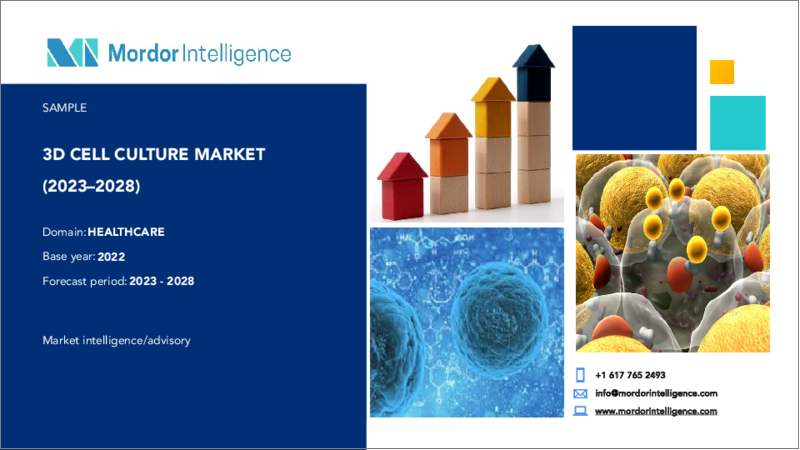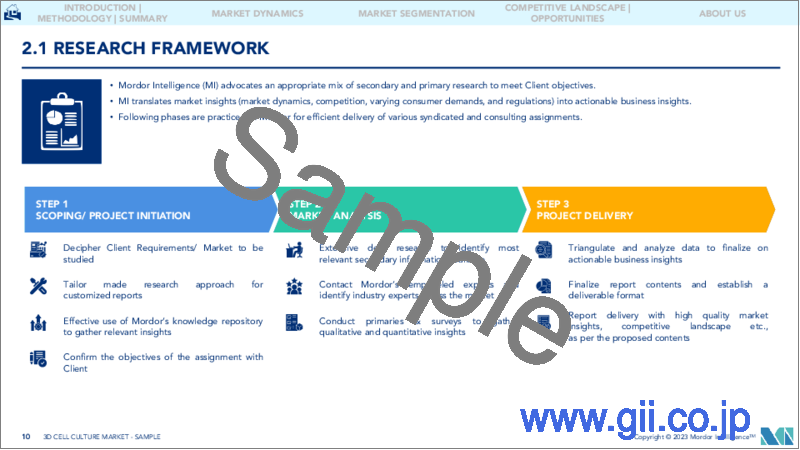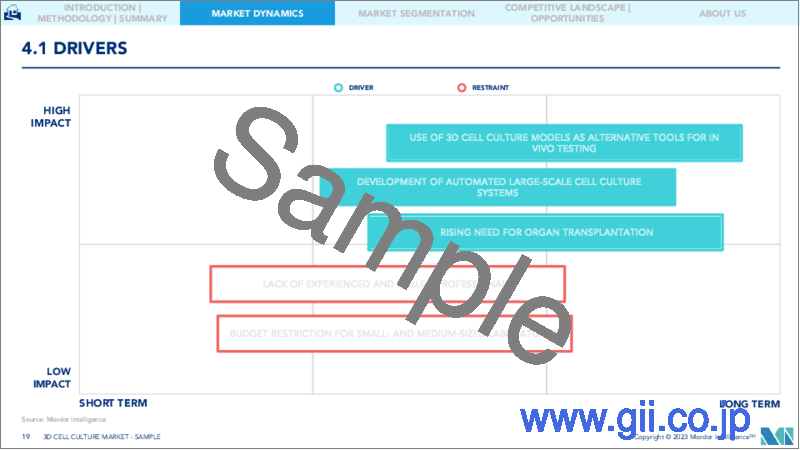|
|
市場調査レポート
商品コード
1195534
3D細胞培養市場- 成長、動向、予測(2023年-2028年)3D Cell Culture Market - Growth, Trends, and Forecasts (2023 - 2028) |
||||||
|
● お客様のご希望に応じて、既存データの加工や未掲載情報(例:国別セグメント)の追加などの対応が可能です。 詳細はお問い合わせください。 |
|||||||
| 3D細胞培養市場- 成長、動向、予測(2023年-2028年) |
|
出版日: 2023年01月23日
発行: Mordor Intelligence
ページ情報: 英文 116 Pages
納期: 2~3営業日
|
- 全表示
- 概要
- 目次
3D細胞培養市場は、予測期間である2022-2027年に12.5%のCAGRで推移すると予想されています。
COVID-19の大流行が市場に大きな影響を与えることが予想されます。3D細胞培養に関連するマトリックスで、気液界面培養に適したCOVID-19に取り組む研究者は、細胞培養の全身への影響のメカニズムをin vitroで調査し、生理学的微小環境での潜在的治療法をテストする必要があります。これが、COVID-19の研究で3D細胞培養が使用されている1次的な理由です。2021年3月にFrontiers Onlineに掲載された論文「3D Tissue Models as an Effective Tool for Studying Viruses and Vaccine Development」によると、ウイルス感染の研究時に2D組織培養よりも3D組織培養技術を使用する利点があり、その意味はCOVID-19の研究に関してもあるとのことです。また、オルガノイドやスフェロイド培養などの技術は、2D培養よりも正確にウイルス感染系を再現し、2D培養では不可能なケースでもウイルス感染を可能にするために必要な形態や生化学的挙動を作り出すことが示されています。
3D細胞培養市場は、in vivo試験の代替ツールとしての3D細胞培養モデルの使用、大規模自動細胞培養システムの開発、臓器移植のニーズの高まりなどの要因により、安定した成長を示しています。3D細胞培養および共培養モデルは、従来の2D細胞培養よりも生体内に近い状況で薬物の安全性と有効性を評価できるだけでなく、ヒトのシステムで直接薬物試験を可能にすることで、前臨床結果の解釈に制約をもたらす種の違いを排除できるため、大きな利点を持っているのです。さらに、臓器移植の需要の増加に伴い、ヒトの生理学、病理学、薬物反応の複雑な側面を試験管内で再現する必要があるため、3次元細胞培養の需要があると思われます。米国保健資源サービス庁のウェブサイト「organdonor.gov」によると、2021年10月、2020年の全米臓器移植待機者数は107,103人だったとのことです。また、同サイトのデータによると、毎年、米国では39,000件の臓器移植が行われているとのことです。このように、臓器移植の増加は、3D細胞培養が使用される研究モデルの需要を高めています。これが市場成長を後押しすると期待されています。
3D細胞培養の市場動向
製品のマイクロチップセグメントは、予測期間中に大幅な成長率を示すと予想される
マイクロチップは、オルガン・オン・ア・チップまたはマイクロシステムとも呼ばれています。マイクロチップは、マイクロチップ業界の様々な技術を使用して、微細加工された3Dデバイス内で培養される細胞とマイクロ流体技術を統合することができます。例えば、2019年6月にAnalytical Methods誌に掲載された「PC12細胞の3D細胞培養とマイクロチップによる電気化学検出の統合」という研究では、マイクロチップがドーパミンとノルエピネフリン放出を分離して検出できることが確認されています。このように、3次元細胞培養装置で作製されたマイクロチップは、神経伝達物質のリアルタイム分析に役立ち、予測期間中に同セグメントを拡大させる。
2次元(2D)培養モデルや動物モデルは、メカニズム研究や薬剤開発に使用されてきました。しかし、2次元モデルや動物モデルは、細胞の種類や性質などの点で、ヒト組織の生理機能を模倣することができないです。そのため、従来のモデルではヒトを正確に反映することができず、薬物治療に関連する生体内反応を正確に予測することができませんでした。この点から、多くの産業界が動物モデルやフラスコ細胞培養モデルに代わる新しいプラットフォームを模索・開発しており、最近では、細胞実験や薬剤スクリーニングの代替候補として、オルガンオンチップ(OoC)が登場しています。
これらのチップの最大の利点は、低コストで製造できることです。これらのチップは、薬の投与量に応じた幅広い濃度のテストを可能にします。このような利点から、主に科学研究をかなり加速させるために、マイクロチップの需要を促進させることが期待されています。近年、創薬プロセスにおける臓器チップ技術の革新的な利用が進んでいます。例えば、2019年3月、民間宇宙探査会社SpaceXは、人間の生理学の様々な側面をモデル化するために設計された生きた人間の細胞を埋め込んだ4つのマイクロチップを搭載したドラゴン貨物カプセルを近々打ち上げる予定だと発表しました。これにより、分析のスピードが上がり、人間の生理学に関する洞察が得られ、後の医薬品開発に生かされることが期待されます。
その結果、前述の利点とマイクロチップの研究により、3D細胞培養技術が市場の成長を促進すると予想されます。
北米が最大の市場シェアを獲得し、今後もその優位性を維持すると予想される
3D細胞培養市場全体では、北米が圧倒的なシェアを占めており、中でも米国が大きく貢献しています。米国は研究開発に力を入れており、過去数年にわたり3D細胞培養の研究に多大な投資を行っています。その結果、同国では技術的な進歩がもたらされました。3D細胞培養分野の主な特許出願人には、米国の出願人が多いのが特徴です。米国の出願人は、米国やアジアで技術開発を行う傾向があります。
また、過去数年間、米国では生物工学の分野に莫大な投資が行われてきました。バイオエンジニアリングには、3次元細胞培養の研究も含まれます。国立衛生研究所によると、2020年、様々なバイオエンジニアリング技術への投資総額は5,646米ドルに達し、2019年の5,091米ドルから増加しました。これらの要因は、米国の3D細胞培養市場を増強しています。
さらに、人間の生理学、病理学、薬物反応の複雑な要素を試験管内で模倣することが求められています。同地域では、臓器移植の需要が高まっているため、3D細胞培養の需要も見込まれます。カナダ健康情報研究所によると、2021年にはカナダ(ケベック州を含む)で合計3,014件の移植手術(全臓器)が行われ、2010年から42%増加しました。したがって、前述のすべての要因が、予測期間中に同地域の市場を押し上げると予想されます。
3D細胞培養市場の競合他社分析
3D細胞培養市場は、競争が激しく、複数の大手企業で構成されています。市場シェアの観点では、現在、少数の主要プレイヤーが市場を独占しています。Corning Incorporated、Lonza AG、Merck KGaA、Thermo Fisher Scientificなどの主要な市場プレイヤーの存在が、市場全体の競争企業間の敵対関係を高めています。
その他の特典。
- エクセル形式の市場予測(ME)シート
- アナリストによる3ヶ月間のサポート
目次
第1章 イントロダクション
- 調査の前提条件と市場の定義
- 調査対象範囲
第2章 調査手法
第3章 エグゼクティブサマリー
第4章 市場力学
- 市場概要
- 市場促進要因
- In Vivo試験の代替ツールとしての3次元細胞培養モデルの利用
- 自動化された大規模細胞培養システムの開発
- 臓器移植のニーズが高まっている
- 市場抑制要因
- 経験豊富で熟練したプロフェッショナルの不足
- 中小ラボの予算制限
- ファイブフォース分析分析
- 新規参入業者の脅威
- 買い手/消費者の交渉力
- 供給企業の交渉力
- 代替品の脅威
- 競争企業間の敵対関係
第5章 市場セグメンテーション(金額ベース市場規模:100万米ドル)
- 製品別
- スキャフォールドベースの3D細胞培養装置
- マイクロパターンマイクロプレート
- ハイドロゲル
- その他の製品
- 無足場3次元細胞培養装置
- ハンギングドロップマイクロプレート
- マイクロ流体3次元細胞培養
- その他の製品
- マイクロチップ
- 3次元バイオリアクター
- スキャフォールドベースの3D細胞培養装置
- アプリケーション別
- 創薬
- 組織工学
- 臨床応用
- その他の用途
- エンドユーザー別
- 研究機関・研究所
- バイオテクノロジー企業、製薬企業
- その他のエンドユーザー
- 地域別
- 北米
- 米国
- カナダ
- メキシコ
- 欧州
- ドイツ
- 英国
- フランス
- イタリア
- スペイン
- その他の欧州地域
- アジア太平洋地域
- 中国
- 日本
- インド
- オーストラリア
- 韓国
- その他アジア太平洋地域
- 中東地域
- GCC
- 南アフリカ
- その他の中東地域
- 南米
- ブラジル
- アルゼンチン
- その他の南米地域
- 北米
第6章 競合情勢
- 企業プロファイル
- BiomimX SRL
- CN Bio Innovations
- Corning Incorporated
- Hurel Corporation
- InSphero AG
- Lonza AG
- Merck KGaA
- MIMETAS BV
- Nortis Inc.
- Thermo Fisher Scientific
- Sartorius AG
- Promocell GmbH
第7章 市場機会と今後の動向
The 3D cell culture market is expected to register a CAGR of 12.5% during the forecast period, 2022-2027.
The COVID-19 pandemic is expected to have a significant impact on the market. Researchers working on COVID-19 with relevant matrices for 3D cell culture and suitable for air-liquid interface culture need to investigate in vitro the mechanisms of the systemic consequences of cell cultures and to test potential therapies in a physiological microenvironment. This is the primary reason why 3D cell cultures are used in COVID-19 research. According to an article appearing in Frontiers Online in March 2021 titled, 3D Tissue Models as an Effective Tool for Studying Viruses and Vaccine Development, there are benefits of using 3D tissue culture techniques over 2D tissue culture when studying viral infections and the implications with regards to studying COVID-19. The study also found that techniques like organoids and spheroid cultures have been shown to replicate systems of viral infection more accurately than 2D cultures and to produce morphology and biochemical behaviors required to allow for viral infection in cases where 2D cultures do not.
The 3D cell culture market is witnessing stable growth due to factors like the use of 3D cell culture models as alternative tools for in vivo testing, the development of large-scale automated cell culture systems, and the rising need for organ transplantation. The 3D cell culture and co-culture models have huge benefits since they not only enable drug safety and efficacy assessment in a more in vivo-like context than traditional 2D cell cultures, but they can eliminate the species differences that pose limitations in the interpretation of the preclinical outcomes, by allowing drug testing directly in human systems. Additionally, with the increase in demand for organ transplantation, there is likely to be a demand for 3D cell cultures as there is a need to recapitulate complex aspects of human physiology, pathology, and drug responses in vitro. According to the organdonor.gov website of the United States Health Resources and Services Administration, in October 2021, 107,103 patients were on the national organ transplant waiting list in the year 2020. Data from the website also states that each year, 39,000 organ transplants are conducted in the United States. Thus, the increase in organ transplants is increasing the demand for research models where 3D cell cultures are used. This is expected to boost the market growth.
3D Cell Culture Market Trends
The Microchips Segment under Product is Expected to see Significant Growth Rate Over the Forecast Period
Microchips are also called organ-on-a-chip or microsystems. Microchips can integrate microfluidic technologies with cells that are cultured within the microfabricated 3D devices, using various techniques from the microchip industry. For instance, the study published in the Analytical Methods in June 2019, titled Integrating 3D cell culture of PC12 cells with microchip-based electrochemical detection, identified that microchip was able to separate and detect dopamine and norepinephrine release. Thus, microchips fabricated with 3D cell culture devices help in the real-time analysis of neurotransmitters boost the segment over the forecast period.
2-dimensional (2D) culture models and animal models have been used for mechanism research and drug development. However, 2D models and animal models cannot mimic the physiology of human tissue in terms of the number of cell types and properties. Thus, conventional models cannot precisely reflect humans and have not been able to accurately predict in vivo responses related to drug treatment. In this regard, many industries have been looking for and developing a new platform to replace animal models or flask cell-culture models, and recently, organs-on-a-chip (OoCs) emerged as an alternative candidate for cell experiments and drug screening.
The main advantage of these chips is that they can be manufactured at a low cost. They allow for testing a wide range of concentrations in the dosage of medicine. This advantage is expected to drive the demand for microchips, primarily to considerably accelerate scientific research. In recent years, there have been innovative uses of organ chip technology for the drug discovery process. For example, in March 2019, the private space exploration company SpaceX announced that it plans to soon launch a Dragon cargo capsule that will contain four microchips embedded with living human cells designed to model various aspects of human physiology. This is expected to speed up analysis and glean insights on human physiology that can be used later for drug development.
As a result, due to the aforementioned advantages and research in microchips, 3D cell culture technologies are expected to drive the market's growth.
North America Captured the Largest Market Share and is Expected to Retain its Dominance
North America dominates the overall 3D cell culture market, with the United States being the major contributor to the market. The United States is focusing on R&D and has been making significant investments in research on 3D cell culture for the past few years. This has resulted in technological advancements in the country. Many American applicants feature among the main patent applicants for the 3D cell culture domain. American applicants tend to develop their technologies in the United States, as well as in Asia.
There have also been huge investments in the bioengineering sector in the United States over the past few years. Bioengineeringinvolves 3D cell culture research too. According to the National Institute of Health, in 2020, the total investment in various bio engineering technologies amounted to USD 5,646, an increase from USD 5,091 in 2019. These factors have augmented the US 3D cell culture market.
Moreover, there is a need to mimic intricate elements of human physiology, pathology, and medication reactions in vitro. There is expected to be a demand for 3D cell cultures as the demand for organ transplantation grows in the region. According to the Canadian Institute for Health Information, in 2021, a total of 3,014 transplant procedures (all organs) were performed in Canada (including Quebec), an increase of 42% since 2010. Thus, all the aforementioned factors are expected to boost the market in the region over the forecast period.
3D Cell Culture Market Competitor Analysis
The 3D cell culture market is highly competitive and consists of several major players. In terms of market share, few of the major players currently dominate the market. The presence of major market players, such as Corning Incorporated, Lonza AG, Merck KGaA, and Thermo Fisher Scientific, is increasing the overall competitive rivalry in the market.
Additional Benefits:
- The market estimate (ME) sheet in Excel format
- 3 months of analyst support
TABLE OF CONTENTS
1 INTRODUCTION
- 1.1 Study Assumptions and Market Definition
- 1.2 Scope of the Study
2 RESEARCH METHODOLOGY
3 EXECUTIVE SUMMARY
4 MARKET DYNAMICS
- 4.1 Market Overview
- 4.2 Market Drivers
- 4.2.1 Use of 3D Cell Culture Models as Alternative Tools for In Vivo Testing
- 4.2.2 Development of Automated Large-scale Cell Culture Systems
- 4.2.3 Rising Need for Organ Transplantation
- 4.3 Market Restraints
- 4.3.1 Lack of Experienced and Skilled Professionals
- 4.3.2 Budget Restriction for Small- and Medium-sized Laboratories
- 4.4 Porter's Five Forces Analysis
- 4.4.1 Threat of New Entrants
- 4.4.2 Bargaining Power of Buyers/Consumers
- 4.4.3 Bargaining Power of Suppliers
- 4.4.4 Threat of Substitute Products
- 4.4.5 Intensity of Competitive Rivalry
5 MARKET SEGMENTATION (Market Size by Value - USD million)
- 5.1 By Product
- 5.1.1 Scaffold-based 3D Cell Cultures
- 5.1.1.1 Micropatterned Surface Microplates
- 5.1.1.2 Hydrogels
- 5.1.1.3 Other Products
- 5.1.2 Scaffold-free 3D Cell Cultures
- 5.1.2.1 Hanging drop microplates
- 5.1.2.2 Microfluidic 3D cell culture
- 5.1.2.3 Other Products
- 5.1.3 Microchips
- 5.1.4 3D Bioreactors
- 5.1.1 Scaffold-based 3D Cell Cultures
- 5.2 By Application
- 5.2.1 Drug Discovery
- 5.2.2 Tissue Engineering
- 5.2.3 Clinical Applications
- 5.2.4 Other Applications
- 5.3 By End User
- 5.3.1 Research Laboratories and Institutes
- 5.3.2 Biotechnology and Pharmaceutical Companies
- 5.3.3 Other End Users
- 5.4 Geography
- 5.4.1 North America
- 5.4.1.1 United States
- 5.4.1.2 Canada
- 5.4.1.3 Mexico
- 5.4.2 Europe
- 5.4.2.1 Germany
- 5.4.2.2 United Kingdom
- 5.4.2.3 France
- 5.4.2.4 Italy
- 5.4.2.5 Spain
- 5.4.2.6 Rest of Europe
- 5.4.3 Asia-Pacific
- 5.4.3.1 China
- 5.4.3.2 Japan
- 5.4.3.3 India
- 5.4.3.4 Australia
- 5.4.3.5 South Korea
- 5.4.3.6 Rest of Asia-Pacific
- 5.4.4 Middle-East
- 5.4.4.1 GCC
- 5.4.4.2 South Africa
- 5.4.4.3 Rest of Middle-East
- 5.4.5 South America
- 5.4.5.1 Brazil
- 5.4.5.2 Argentina
- 5.4.5.3 Rest of South America
- 5.4.1 North America
6 COMPETITIVE LANDSCAPE
- 6.1 Company Profiles
- 6.1.1 BiomimX SRL
- 6.1.2 CN Bio Innovations
- 6.1.3 Corning Incorporated
- 6.1.4 Hurel Corporation
- 6.1.5 InSphero AG
- 6.1.6 Lonza AG
- 6.1.7 Merck KGaA
- 6.1.8 MIMETAS BV
- 6.1.9 Nortis Inc.
- 6.1.10 Thermo Fisher Scientific
- 6.1.11 Sartorius AG
- 6.1.12 Promocell GmbH




